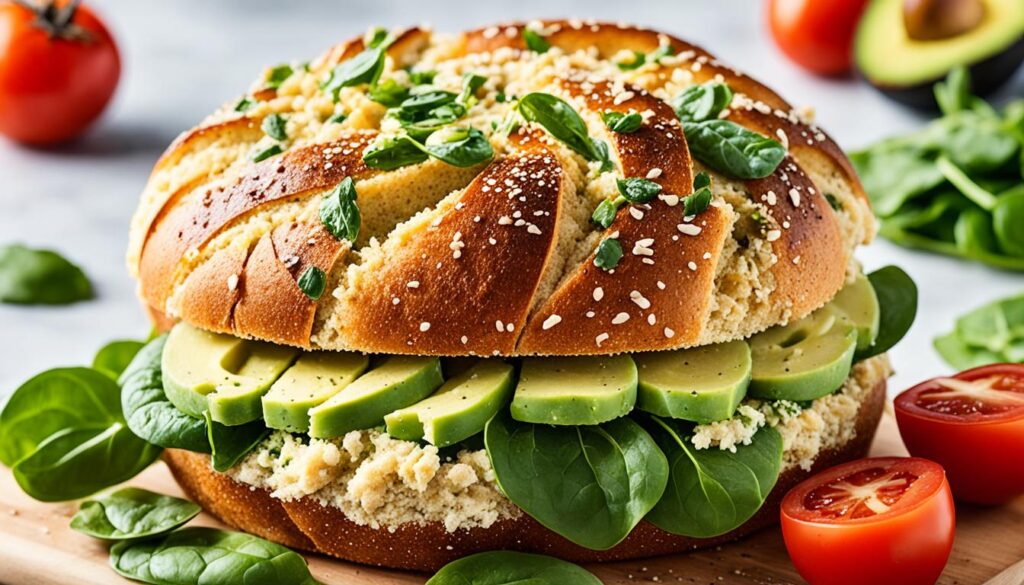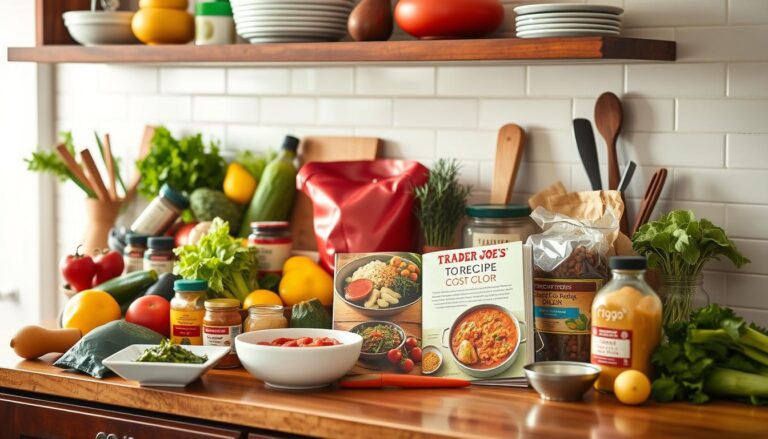Sourdough dinner rolls are a delightful addition to any meal. They are soft, fluffy, and tangy. These rolls are perfect with your favorite dishes, like hearty stews or savory roasts. Their unique fermentation process gives them a special sourdough flavor and aroma.
Key Takeaways
- Sourdough dinner rolls are soft, fluffy, and have a tangy flavor from the fermentation process.
- The intensity of the sourdough taste can be adjusted by controlling the fermentation time.
- Homemade sourdough dinner rolls are an easy and delicious way to elevate any meal.
- The fermentation process increases the availability of nutrients and makes the bread easier to digest.
- Using a ripe sourdough starter and simple ingredients like flour, milk, and butter creates a bakery-style roll at home.
What are Sourdough Dinner Rolls?
Sourdough dinner rolls are a tasty and exciting addition to any meal. They are soft and fluffy, thanks to a naturally fermented sourdough starter. This starter gives them a unique tangy sourdough flavor.
The fermentation process also makes the rolls wonderfully soft and airy.
Soft, Fluffy, and Tangy Bread
The secret to the perfect soft sourdough rolls is the sourdough starter. This starter is fermented with wild yeasts and beneficial bacteria. It adds a delightful tanginess that makes these rolls stand out.
The result is a fluffy, pillowy interior with a slightly crisp outside. It’s just irresistible.
Fermented with Natural Yeasts
Sourdough dinner rolls are fermented slowly, letting natural yeasts work their magic. This process not only adds to the tangy sourdough flavor. It also makes the bread easier to digest, making it a healthier choice for dinner.
“The natural fermentation process in sourdough bread helps break down the gluten, making it more easily digestible for many people.”
Benefits of Sourdough Bread
Sourdough bread is healthier than regular bread because of its special way of making it. This process makes the grains more nutritious. It’s also easier to digest for people who have trouble with certain foods.
Increased Nutrient Availability
The making of sourdough bread boosts the nutrients like B vitamins, iron, and minerals. The yeasts and bacteria in it break down tough carbs and proteins. This makes these nutrients easier for our bodies to use.
Easier Digestion
Sourdough bread is easier on the stomach for some folks. The process of making it breaks down the gluten and other parts of the grains. This is good news for those who have gluten issues or trouble digesting certain foods. So, sourdough is a better choice than regular bread for many people.
| Nutrient | Sourdough Bread | Yeast Bread |
|---|---|---|
| Folate | 25% higher | 15% lower |
| Magnesium | 20% higher | 10% lower |
| Zinc | 30% higher | 5% lower |

“Sourdough bread has been shown to have a lower glycemic index compared to conventional yeast-based bread, which can be beneficial for those with diabetes or blood sugar management concerns.”
sourdough dinner rolls Ingredients
For delicious sourdough dinner rolls, you need the right ingredients. You’ll need a ripe sourdough starter, all-purpose flour, whole milk, and unsalted butter. These simple items are key to making the rolls.
Ripe Sourdough Starter
A bubbly, active sourdough starter is crucial. It gives the dough its natural yeast. This yeast makes the dough rise and adds a tangy flavor. Make sure your starter is mature and ready before adding it to the mix.
Flour, Milk, and Butter
You also need all-purpose flour for the dough’s structure. Whole milk adds moisture and richness. Unsalted butter makes the rolls soft and tender. Together, these ingredients create the perfect texture and taste.
“The combination of a ripe sourdough starter, all-purpose flour, whole milk, and unsalted butter is the secret to making delicious, homemade sourdough dinner rolls.”
Preparing the Levain
Creating a flavorful sourdough dinner roll begins with making the levain. The levain mixes ripe sourdough starter, flour, and water. It ferments overnight, building the tangy aroma and complex flavors in the rolls.
To make the levain for your sourdough dinner rolls, follow these steps:
- Gather your sourdough starter and make sure it’s ripe, bubbly, and active.
- In a clean bowl, mix the ripe starter with equal parts of flour and water. Use 50g of starter, 50g of flour, and 50g of water as a starting point.
- Stir the mix well, then cover it. Let it ferment at room temperature for 10-12 hours. The starter’s yeasts will eat the flour’s sugars, making it active and bubbly.
When the levain has doubled and looks lively, it’s time to add it to the dough. This step is key in making sourdough levain and feeding sourdough starter for rolls. It leads to a flavorful and tender final product.
| Ingredient | Amount |
|---|---|
| Ripe Sourdough Starter | 50g |
| Flour | 50g |
| Water | 50g |
Mixing and Kneading the Dough
When the levain, or sourdough starter, is ready, it’s time to mix the dough for your tasty sourdough dinner rolls. This important step combines the levain with milk, butter, sugar, salt, and bread flour. Make sure to knead the dough well, either with a stand mixer or by hand, until it’s smooth, stretchy, and passes the windowpane test.
Using a Stand Mixer or Kneading by Hand
With a stand mixer, put the levain, milk, melted butter, sugar, and salt in the bowl. Then, use the dough hook attachment and knead on medium speed for 10-15 minutes. The dough should be smooth and elastic. Kneading the dough by hand is also an option. It can be calming. Knead on a lightly floured surface for 10-15 minutes, until it passes the windowpane test.
| Stand Mixer | Hand Kneading |
|---|---|
| Efficient and consistent kneading | Hands-on approach, can be therapeutic |
| Suitable for those with limited time or physical ability | Allows for better feel and control of the dough |
| Requires less physical effort | Develops stronger gluten structure |
Choosing any method, aim to develop the dough’s gluten structure. This makes your sourdough dinner rolls soft and pillowy. With practice, you’ll master kneading the sourdough dough, whether with a stand mixer or by hand.
Bulk Fermentation
The bulk fermentation stage is key in making sourdough dinner rolls. After kneading, the dough goes into a greased bowl, covered, and ferments for about 4 hours. This is done at a temperature of 78-80°F. This temperature is perfect for sourdough bulk fermentation. It helps the dough’s gluten develop and improves its flavor.
During bulk fermentation, the dough should get a bit bigger and airy. This happens because the sourdough starter’s yeasts eat the sugars and make carbon dioxide. This makes the dough rise. The longer it ferments, the more complex its flavor will be. This is because the yeasts keep breaking down the flour’s starches and proteins.
Keeping an eye on the temperature is crucial during this stage. The temperature for bulk fermentation greatly affects the rolls’ texture and taste. If it’s too high, the dough may rise too fast, making it dense and heavy. If it’s too low, the fermentation will be slow, and the flavor won’t develop well.
| Bulk Fermentation Parameter | Recommended Range |
|---|---|
| Temperature | 78-80°F |
| Duration | 4 hours |
By controlling the sourdough bulk fermentation temperature and time, bakers can get the dough just right. This leads to delicious and satisfying sourdough dinner rolls.
Shaping the Rolls
After the dough has fermented, it’s time to shape the sourdough dinner rolls. This step is key for the perfect texture and rise. Let’s explore how to shape these tasty rolls.
Start by dividing the dough into 12 equal parts. This makes sure each roll cooks evenly. Then, shape each piece into a smooth, tight ball. It’s important to pull the dough sides together and pinch them at the bottom. This method, called “shaping,” keeps the rolls in shape during baking.
Shaping the rolls not only makes them look great but also affects their texture. The tension in the dough traps gas bubbles inside. This results in soft, fluffy rolls with a lightly crisp crust. This mix of textures is what makes sourdough dinner rolls so special.
For the best results, take your time and be gentle when shaping the dough. Don’t overwork the dough, as it can ruin the delicate structure. With practice, you’ll get the hang of shaping sourdough rolls. This will help you achieve the perfect rise and bake.
Proofing the Rolls
After shaping the sourdough rolls, it’s time to let them proof and rise before baking. This step is key for getting the perfect rise time for sourdough rolls. It makes the bread light, fluffy, and airy.
The shaped dough balls go into a greased baking dish, covered, and proof for 3-4 hours at 80-85°F. They will puff up and double in size, becoming perfectly proofed and ready for the oven.
For even proofing of the sourdough rolls, keep the area warm and humid. You can do this by placing the dish in a warm oven with the light on, or in a proofing box or other warm, humid spot.
- Ideal proofing temperature: 80-85°F
- Proofing time: 3-4 hours
- The rolls should double in size during proofing
Once the rolls are proofed and light, they’re ready to be baked. This makes a delicious and satisfying sourdough dinner rolls that will impress everyone.
Baking Sourdough Dinner Rolls
It’s time to bake the sourdough dinner rolls to golden, fluffy perfection. The secret is in the oven temperature and baking time. These factors will help you achieve the perfect bake for your homemade sourdough rolls.
Temperature and Time
Preheat your oven to 375°F (190°C). This temperature is ideal for baking the rolls evenly. It helps them develop a beautiful golden-brown crust without overbrowning. Once the oven is hot, place the proofed rolls on a baking sheet or in a preheated cast-iron skillet.
Bake the rolls for 25 to 30 minutes. They should reach an internal temperature of 190-195°F (88-91°C). This ensures they are fully cooked, with a soft interior and a crisp exterior. Always watch the rolls closely, as oven temperatures can vary. You might need to adjust the baking time.
To get a soft, shiny crust, brush the rolls with melted butter or oil right after they come out of the oven. This adds flavor and texture to your baking sourdough rolls.
| Parameter | Value |
|---|---|
| Oven Temperature | 375°F (190°C) |
| Baking Time | 25-30 minutes |
| Internal Temperature | 190-195°F (88-91°C) |
“The secret to perfectly baked sourdough dinner rolls is in the oven temperature and timing. With a little care and attention, you can achieve a delightful balance of crisp crust and soft, fluffy interior.”
Conclusion
Making easy homemade sourdough rolls is a fun and rewarding task. These family-friendly sourdough rolls bring the great taste and health perks of sourdough bread right to your kitchen. By following simple steps, you can make homemade artisan bread that’s as good as what you’d buy in a bakery.
The rolls are soft, fluffy, and have a tangy taste that’s just right. They’re perfect for many meals, like with soup, in sandwiches, or just on their own. These family-friendly sourdough rolls will quickly become a favorite at home.
Try your hand at homemade artisan bread and enjoy making these tasty easy homemade sourdough rolls. It’s a great way to improve your cooking skills and impress your family with delicious sourdough treats.










